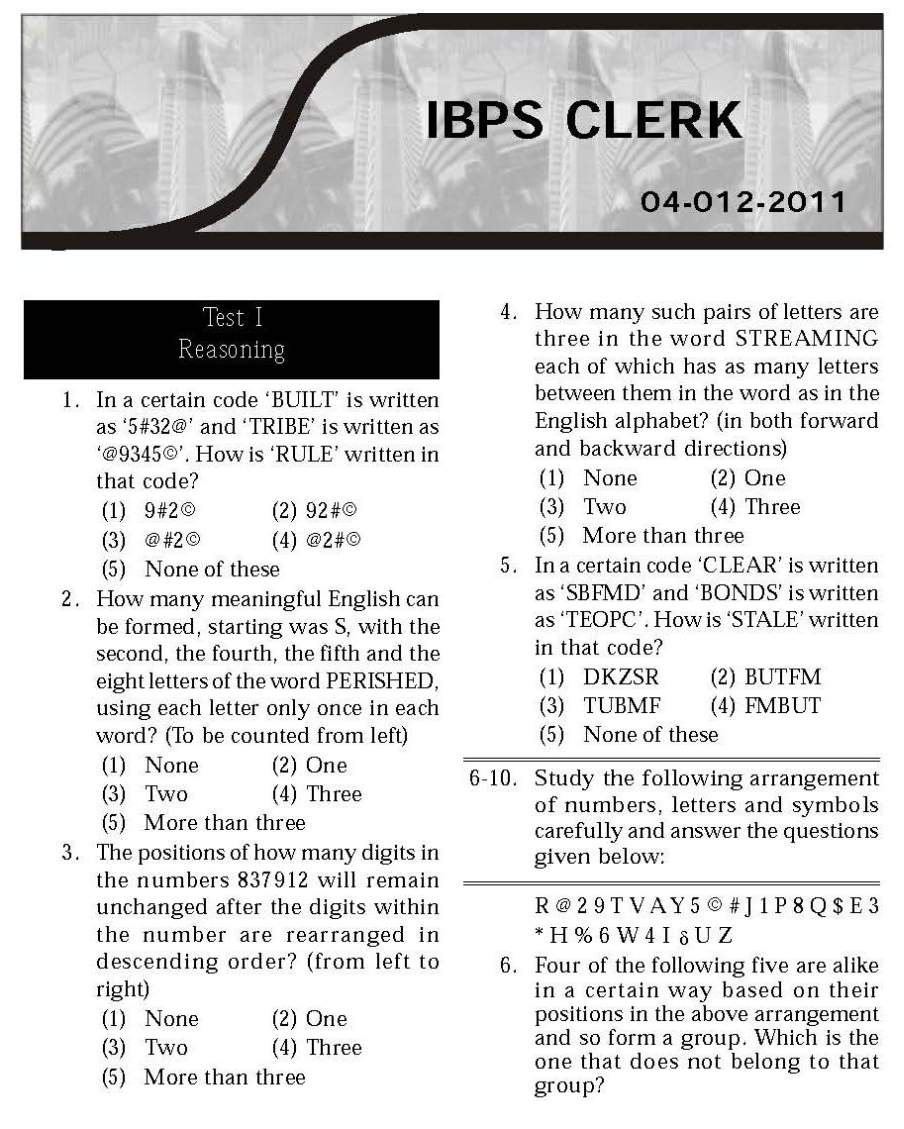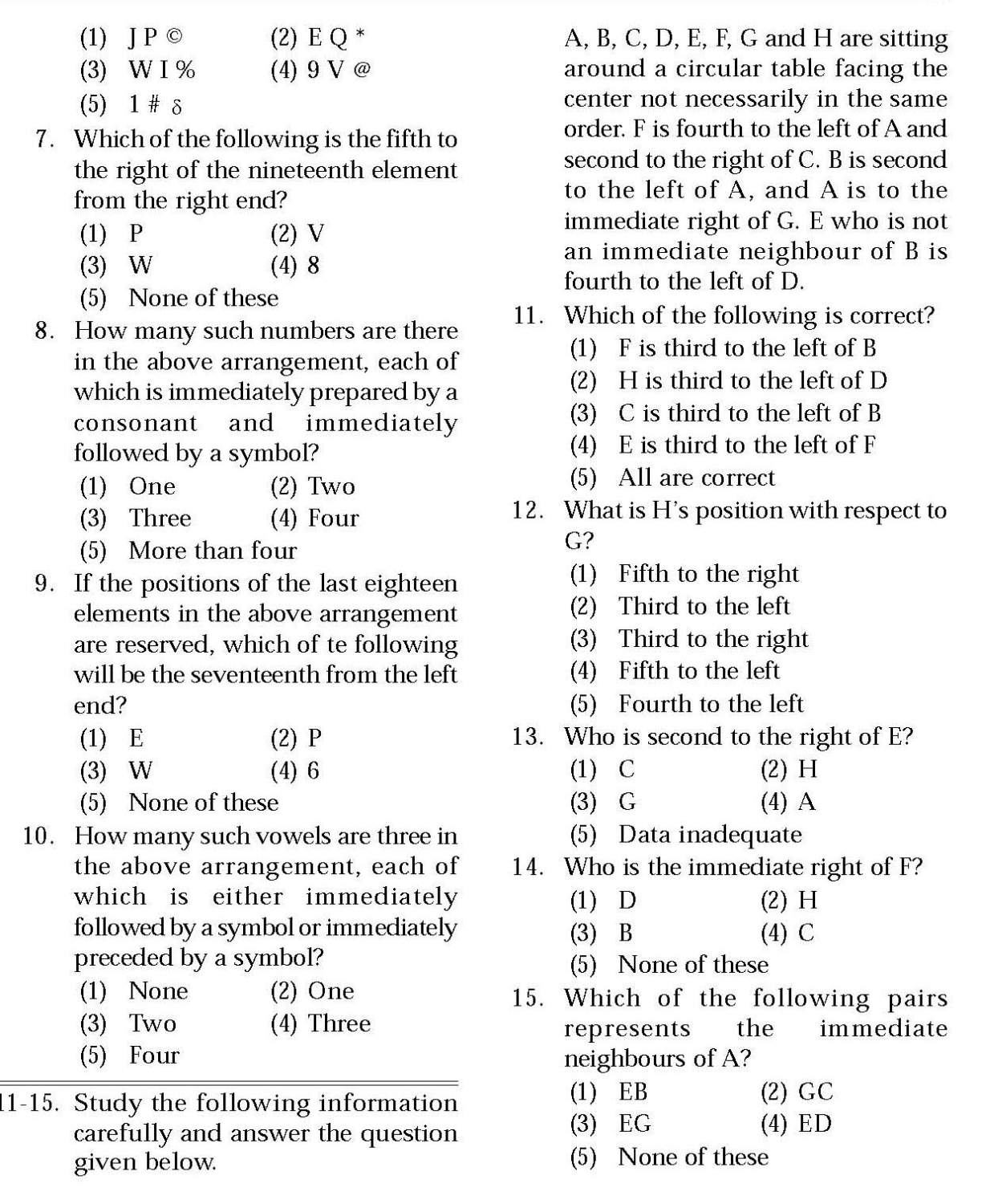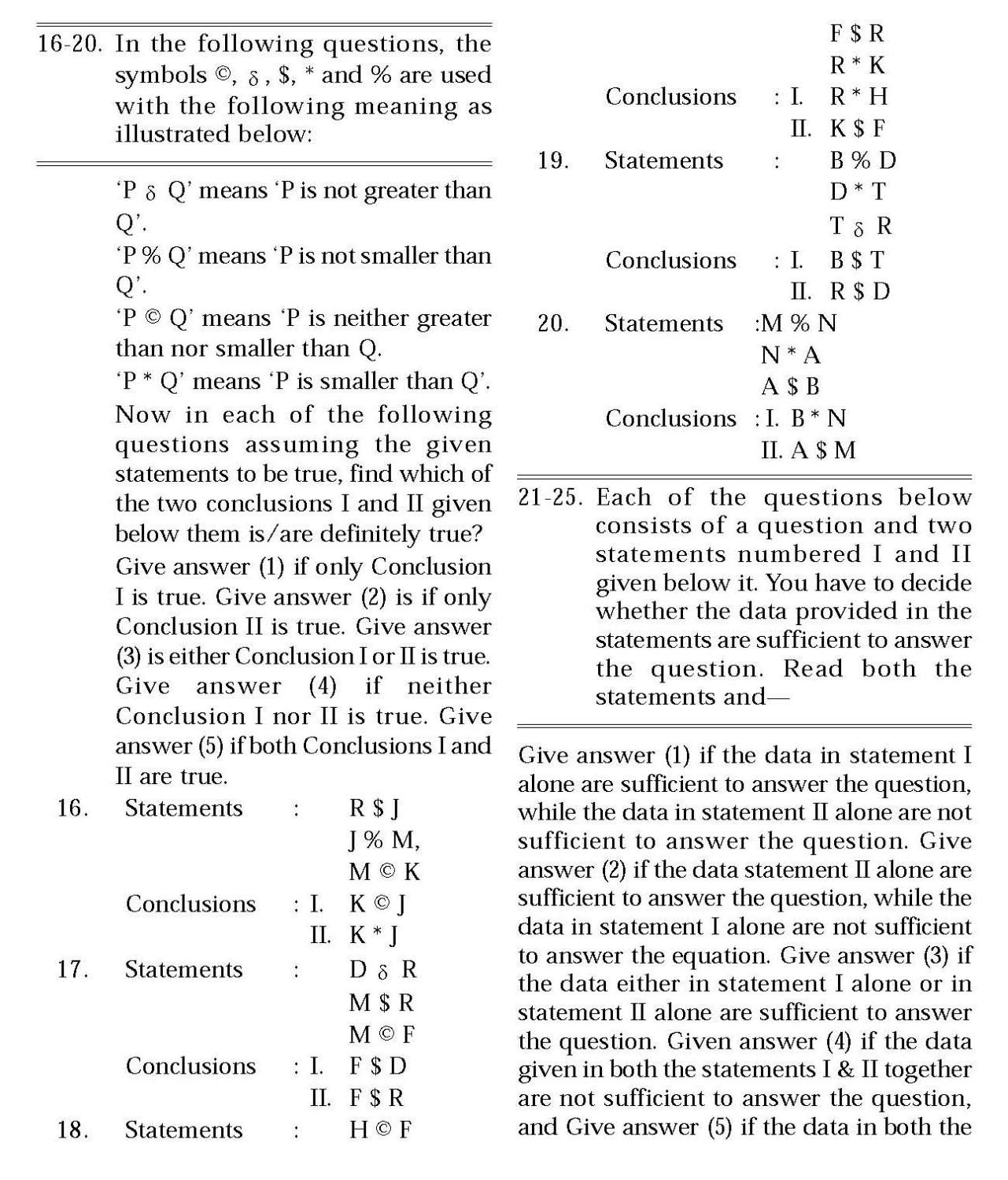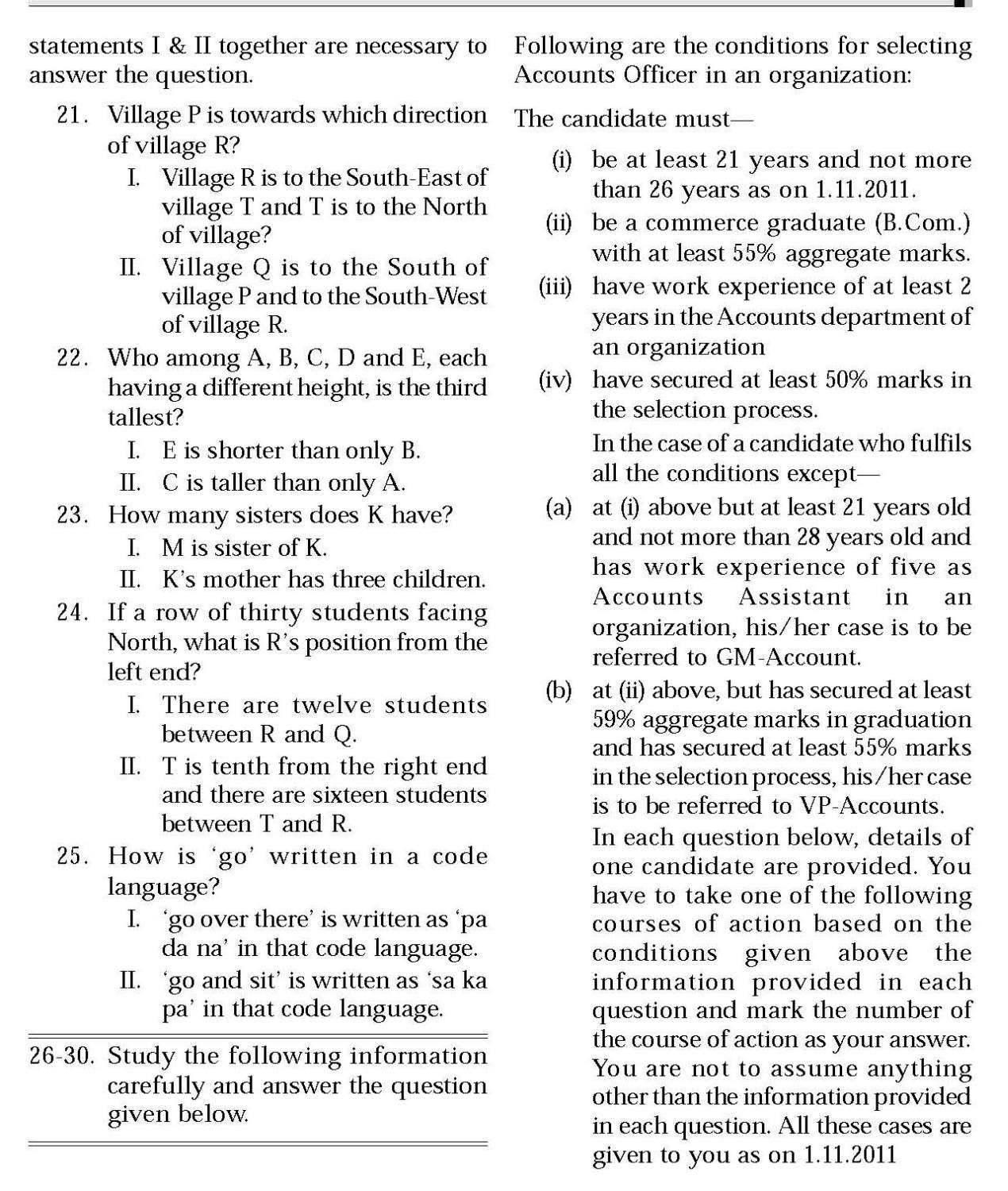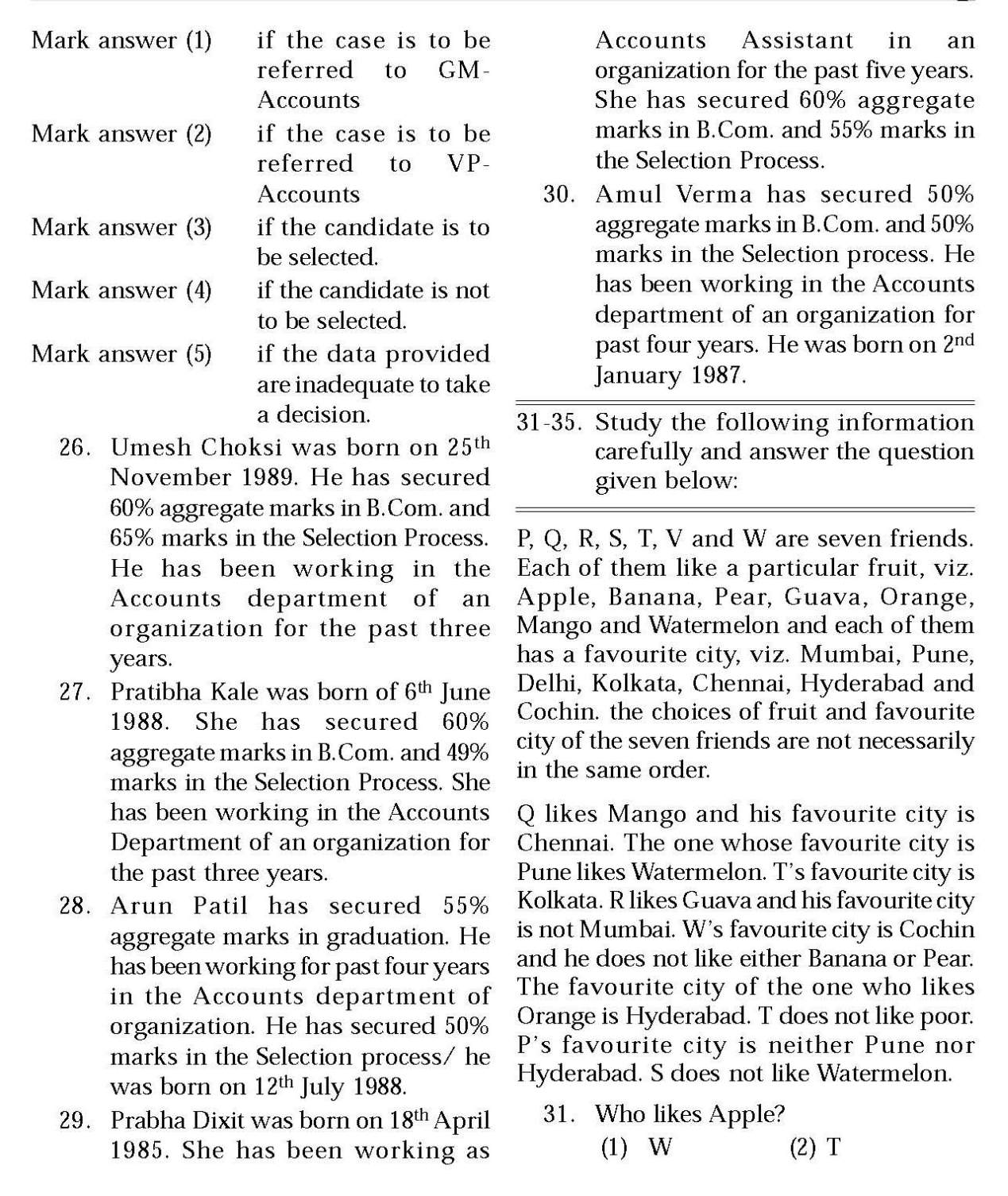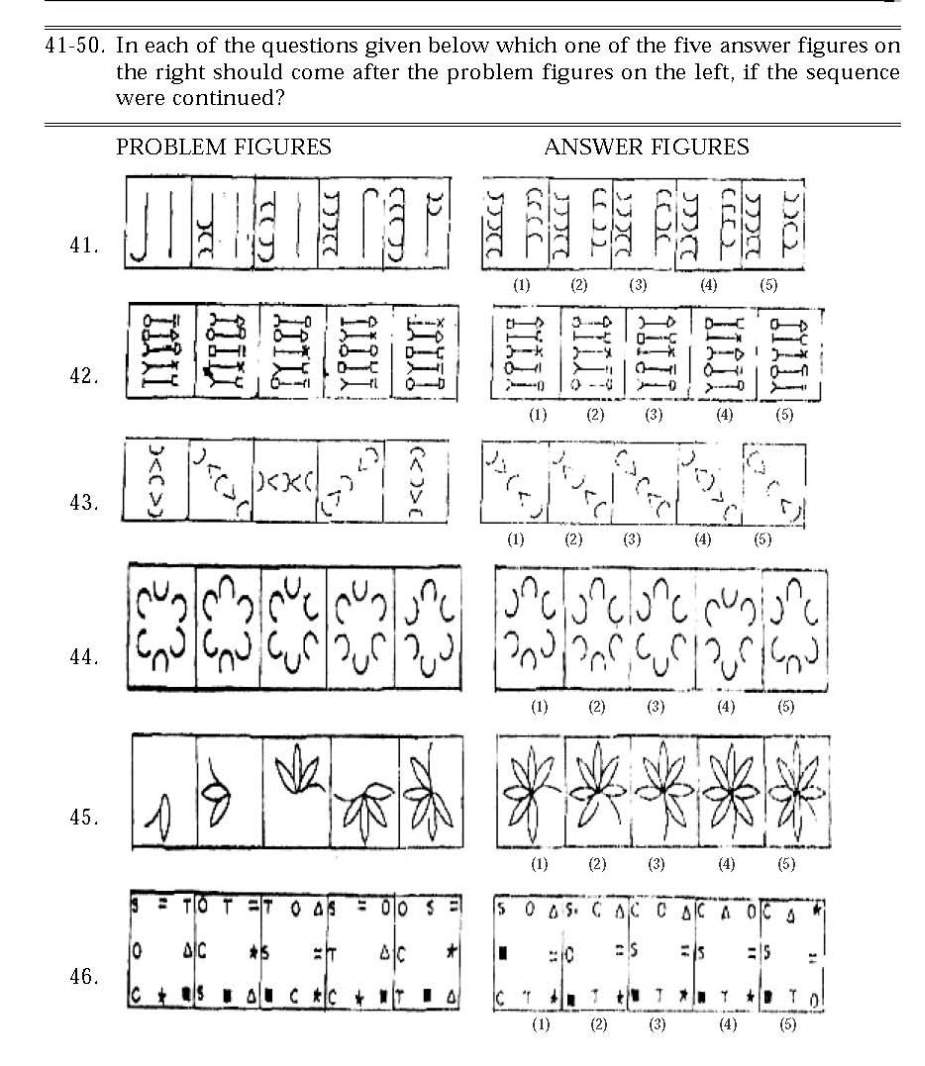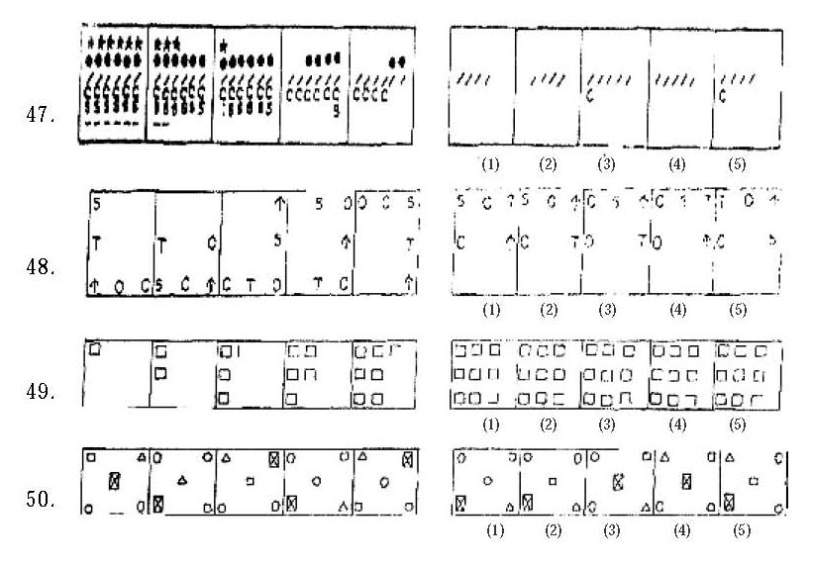| Re: Solved paper IBPS Clerk Exam
In India, a series of Common Written Examinations (CWEs) are conducted every year for the posts of Probationary Officer / Clerk/ Management Trainee/ Specialist Officer, in Public Sector banks Regional Rural Banks.
This written examination is conduct by the IBPS (Institute of Banking Personnel Selection).
The questions are objective in nature consisting of four papers.
Reasoning Ability
Numerical Aptitude
Clerical Aptitude
English Language
General Awareness
Question paper:
Test I
Reasoning
1-4. Study the following information carefully
and answer the given questions:
A word and number arrangement machine
when given an input line of words and numbers
rearranges them following a particular rule in
each step. The following is an illustration of
input and rearrangement. (All the numbers are
two digits numbers)
Input : tall 38 13 rise alt 99 76 32 wise jar
high 28 56 barn
Step I : 13 tall 48 rise 99 76 32 wise jar high
28 56 barn alt
Step II : 28 13 talk 48 ruse 99 76 32 wise jar
high 56 alt barn
Step III : 32 28 13 tall 48 rise 99 76 wise jar 56
alt barn high
Step IV : 48 32 28 13 tall rise 99 76 wise 56 alt
barn high jar
Step V : 56 48 32 28 13 tall 99 76 wise alt barn
high jar rise
Step VI : 76 56 48 32 28 13 99 wise alt barn
high jar rise tall
Step VII : 99 76 56 48 32 28 13 alt barn high jar
rise tall wise
And Step VII is the last step of the
above input, as the desired
arrangement is obtained.
As per the rules followed in the
above steps, find out in each of the
following questions the
appropriate step for the given
input.
Input : 84 why sit 14 32 not best ink feet 51
27 vain 68 92
(All the numbers are two digits
numbers)
1. Which step number is the following
output?
32 27 14 84 why sit not 51 vain 92 68
feet best ink
(a) Step V (b) Step VI
(c) Step IV (d) Step III
(e) There is not such step
2. Which word/number would be at 5th
position from the right in Step V?
(a) 14 (b) 92
(c) feet (d) best
(e) why
3. How many elements (words or
2
numbers) are there between ‘feet’ and
‘32’ as they appear in the last step of
the output?
(a) One (b) Three
(c) Four (d) Five
(e) Seven
4. Which of the following represents the
position of ‘why’ in the fourth step?
(a) Eight from the left
(b) Fifth from the right
(c) Sixth form the left
(d) Fifth from the left
(e) Seventh from the left
5-11.Study the following information carefully
and answer the given questions:
• A, B, C, D, E, F, G and H are sitting around a
circle facing the centre but not necessarily in
the same order.
• B sits second to left of H’s husband. No female
is an immediate neighbor of B.
• D’s daughter sits second to right of F. F is the
sister of G. F is not an immediate neighbor of
H’s husband.
• Only one person sits between A and F. A is the
father of G. H’s brother D sits to the immediate
left of H’s mother. Only one person sits
between H’s mother and E.
• Only one person sits between H and G. G is
the mother of C. G is not an immediate
neighbor of E.
5. What is position of A with respect to
his mother-in-law?
(a) Immediate left
(b) Third to the right
(c) Third to the left
(d) Second to the right
(e) Fourth to the left
6. Who amongst the following is D’s
daughter?
(a) B (b) C
(c) E (d) G
(e) H
7. What is the position of A with respect
to his grandchild?
(a) Immediate right
(b) Third to the right
(c) Third to the left
(d) Second to the left
(e) Fourth to the left
8. How many people sit between G and
her uncle?
(a) One (b) Two
(c) Three (d) Four
(e) More than four
9. Four of the following five are alike in a
certain was based on the given
information and so form a group.
Which is the one that does not belong
to that group?
(a) F (b) C
(c) E (d) H
(e) G
10. Which of the following is true with
respect to the given seating
arrangement?
(a) C is the cousin of E
(b) H and H’s husband are immediate
neighbours of each other
(c) No female is an immediate
neighbour of C
(d) H sits third to left of her daughter
(e) B is the mother of H
11. Who sits to the immediate left of C?
(a) F’s grandmother
3
(b) G’s son
(c) D’s mother-in-law
(d) A
(e) G
12-18. In each group of questions below are
two/three statements followed by two
conclusions numbered I and II. You have to take
the given statements to be true even if they
seem to be at variance from commonly known
facts and then decide which of the given
conclusions logically follows from the two/
three statements disregarding commonly
known facts.
Give answer (1) if only conclusion I
follows;
Give answer (2) if only conclusion II
follows;
Give answer (3) if either conclusion I or
conclusion II follows;
Give answer (4) if either conclusion I nor
conclusion II follows;
Give answer (5) if both conclusion I and
conclusion II follow.
12. Statements : Some exams are tests.
No exam is a question.
Conclusions : I.No equation is a test.
II.Some tests are
definitely not exams.
13-14. Statements :All forces are energies.
All energies are powers.
No power is heat.
13. Conclusions : I. Some forces are
definitely not
powers.
II.No heat is forces.
14. Conclusions : I.No energy id heat.
II.Some forces being that
is a possibility.
15-16. Statements : No note is a coin. Some
coins are metals. All
plastics are notes.
15. Conclusions : I. No coin is plastic.
II. All plastics being
metals is a possibility.
16. Conclusions : I.Not metal is plastic.
II. All notes are
plastics.
17. Statements : Some symbols are
figures. All symbols are
graphics.
No graphic is a picture.
Conclusions : I.Some graphics are
figures.
II. No symbol is a
picture.
18. Statements : All vacancies are jobs.
Some jobs are
occupations.
Conclusions : I.All vacancies are
occupations.
II. All occupations
being vacancies is a
possibility.
19-21. Study the following information
carefully to answer the given question:
Each of the six friends, A, B, C, D, E and F second
different marks in an examination. C scored
more than only. A and E. D scored less than
only B. E did not score the least. The one who
scored the third highest marks scored 81 marks.
E scored 62 marks.
4
19. Which of the following could possibly
be C’s score?
(a) 70
(b) 91
(c) 86
(d) 61
(e) 81
20. Which of the following is true with
respect to the given information?
(a) D’s score was definitely less than
60
(b) F scored the maximum marks
(c) Only two people scored more
than C
(d) There is a possibility that B scored
79 marks
(e) None is true
21. The person who scored the maximum,
scored 13 marks more than F’s marks.
Which of the following can be D’s
score?
(a) 94 (b) 60
(c) 89 (d) 78
(e) 81
22-29. Study the following information
carefully to answer the given questions:
Eight person from different viz. UCO
bank, Syndicate bank, Canara bank, PNB, Dena
Bank, Oriental Bank of Commerce, Indian bank
and Bank of Maharashtra are sitting in two
parallel rows containing four people each, in
such a way that there is an equal distance
between adjacent persons. In row-1 A, B, C and
D are seated and all of them are facing with
south. In row-2 P, Q, R and S are seated and all
of them are facing north. Therefore, in the
given seating arrangement each member
seated in a row faces another member of the
other row. (All the information given above
does not necessarily represent the order of
seating as in the final arrangement)
• C sits second to right of the person from Bank
of Maharashtra. R is an immediate neighbour
of the person who faces the person from Bank
of Maharashtra.
• Only one person sits between R and the person
for PNB. Immediate neighbour of the person
from PNB faces the person from Canara Bank.
• The person from UCO bank faces the person
from Oriental Bank of Commerce. R is not from
Oriental Bank of Commerce. P is not from PNB.
P does not face the person from Bank of
Maharashtra.
• Q faces the person from Dena bank. The one
who faces S sits to the immediate left of A.
• B does not sit at any of the extreme ends of
the line. The person from Bank of
Maharashtra does not face the person from
Syndicate bank.
22. Which of the following is true regarding
A?
(a) The person from UCO bank faces
A
(b) The person from Bank of
Maharashtra is an immediate
neighbour of A
(c) A faces the person who sits
second to right of R
(d) A is from Oriental Bank of
Commerce
(e) A sits at one of the extreme ends
of the line
23. Who is seated between R and the
person from PNB?
5
(a) The person from Oriental Bank of
Commerce
(b) P (c) Q
(d) The person from Syndicate bank
(e) S
24. Who amongst the following sit at
extreme ends of the rows?
(a) D and the person from PNB
(b) The person from Indian bank of
UCO bank
(c) The person from Dena bank and
P
(d) The person from Syndicate bank
and D
(e) C, Q
25. Who amongst the following faces the
person Bank of Maharashtra?
(a) The person from Indian bank
(b) P (c) R
(d) The person from Syndicate bank
(e) The person from Canara bank
26. P is related to Dena bank in the same
way as B is related to PNB based on the
given arrangement. To who amongst
the following id D related to, following
the same pattern?
(a) Syndicate bank
(b) Canara Bank
(c) Bank of Maharashtra
(d) Indian bank
(e) Oriental Bank of Commerce
27. Four of the following five are alike in a
certain way based on the given seating
arrangement and thus from a group.
Which is the one that does not belong
to that grop?
(a) Canara bank (b) R
(c) Syndicate bank
(d) Q
(e) Oriental Bank Of Maharashtra
28. Who amongst the following is form
Syndicate bank?
(a) C (b) R
(c) P (d) D
(e) A
29. C is from which of the following banks?
(a) Dena bank
(b) Oriental Bank of Commerce
(c) UCO bank
(d) Syndicate bank
(e) Canara bank
30-34. Each of the question below consists of
a question and three statements numbered I,
II and III given below it. You have to decide
whether the data provided in the statements
are sufficient to answer the question. Read all
the three statements and—
Give answer (1) if the data in Statement I
and II are sufficient to
answer the question,
while the data in
Statement III are not
required to answer the
question
Give answer (2) if the data in Statement I
and III are sufficient to
answer the question,
while the data in
Statement III are not
required to answer the
question
6
Give answer (3) if the
data in Statement II and
III are sufficient to
answer the question,
while the data in
Statement III are not
required to answer the
question
Give answer (4) if the data in either
Statement I alone or
Statement II alone or
Statement III alone are
sufficient to answer the
question.
Give answer (5) if the data in all
Statement I, II and III
together are necessary to
answer the question.
30.Among six people P, Q, R, S, T and V each
lives on a different floor of a six storey
building having six floors numbered
one to six (the ground floor is
numbered 1, the floor above it,
number 2 and so on and the topmost
floor is numbered 6). Who lives o the
topmost floor?
(1) There is only one floor between
the floors on which R and Q live.
P lives on an even numbered
floor.
(2) T does not live on an even
numbered floor. Q lives on an
even numbered floor. Q does not
live on the topmost floor.
(3) S lives on an odd numbered floor.
There are two floors between the
floors on which S and P live. T
lives on a floor immediately
above R’s floor.
31. There are six letters W, A, R, S, N and E.
Is ‘ANSWER’ the word formed after
performing the following operations
using these sex letters only?
(a) E is placed fourth to the right of
A. S is not placed immediately
next to either A or E.
(b) R is placed immediately net
(either left or right) to E. W is
placed immediately next (either
left or right) to S.
(c) Both N and W are placed
immediately next to S. The word
does not begin with R. A is not
placed immediately next to W.
32. Point D is in which direction with
respect to Point B?
(a) Point A is to the west of Point B.
Point C is to the north of Point B.
Point D is 9m from Point B.
(b) Point G is to the south of Point D.
Point G is 4m from Point B. Point
D is 9m from Point B.
(c) Point A is to the west of Point B.
Point B is exactly midway
between Points A and E.
(d) Point F is to the south of Point E.
Point D is to the west of Point F.
33. How is ‘one’ coded in the code
language?
(a) ‘one of its kind’ is coded as ‘zo pi
ko fe’ in kind and cash’ is coded
as ‘ga to ru ko’
7
(b) ‘its point for origin’ is coded as
‘ba le fe mi’ and ‘make a point
clear’ is coded as ‘yu si mi de’
(c) ‘make money and cash’ is coded
as ‘tu mi ru hy’ and ‘money of
various kind’ is coded as ‘qu ko zo
hy’.
34. Are all the four friends viz. A, B, C and
D who are sitting around a circular
table, facing the centre?
(a) B sits second to right of D. D faces
the centre. C sits to immediate
right of both B and D.
(b) A sits to immediate left of B. C is
not an immediate neighbour of
A. C sits to immediate right of D.
(c) D is an immediate neighbour of
both A and C. B sits to the
immediate left of A. C is sits to
the immediate right of B.
35. Read the following information
carefully and answer the question
which follows:
Farmers found using chemical
fertilizers in the organic-farming area
of their farms would be heavily fined.
Which of the following statement is an
assumption implicit in the given
statement?
(a) Chemical fertilizers harm the
crop.
(b) A farm’s area for organic and
chemical farming is different
(c) Farmers who do not use chemical
fertilizers in the chemical farming
area would be penalized as well.
(d) All farmers undertake both these
kinds of farming (chemical as
well as organic) in their farms.
(e) Organic fertilizers are banned in
the area for chemical farming.
36-40. Read the following information
carefully and answer the questions which
follow:
Small brands are now looking beyond local
grocary stores adn are tying up with
Supermarkets such as Big Bazar to pull their
business out of troubled waters.
36. Which of the following can be inferred
from the given information? (An
inference is something that is not
directly states but can be inferred from
the given information)
(a) Merchandise of smaller brands
would not be available at local
grocery stores in the near future.
(b) Smaller brands cannot compete
with bigger one in a supermarket
set-up.
(c) There is a perception among
small brands that sale in a
supermarket is higher than that
of small grocery stores.
(d) Supermarkets generate more
revenue by selling products of
bigger brands as compared to the
smaller ones.
(e) Smaller brands have always had
more tie-ups with supermarkets
as compared to small grocery
stores.
8
37-40. These questions are based on the
information given above and the sentences
labeled (A), (B), (C), (D), (E) and (F), as given
below.
(a) A smaller brand manufacturing a certain
product of quality comparable with that of a
bigger brand, makes much more profit from
the local grocery stores than from the
supermarkets.
(b) As the supermarkets have been set up only in
bigger cities at present, this step would fail
to deliver result in the smaller cities.
(c) Supermarkets help the smaller brands to
break into newer markets without investing
substantially in distribution.
(d) Supermarkets charge the smaller brands 10%
higher than the amount charged to the bigger
brands.
(e) Being outnumbered by the bigger brands,
visibility of the smaller at local grocery stores
is much lower as compared to the
supermarkets.
(f) Smaller brands are currently making
substantial losses in their businesses.
37. Which of the statements numbered
(A), (B), (C), (D), (E) and (F) can be
assumed from the facts/information
given in the statement? (An
assumption is something supposed or
taken for granted)
(a) Only (A)
(b) Only (B)
(c) Both (B) and (C)
(d) Both (D) and (D)
(e) Only (F)
38. Which of the statements numbered
(A), (B), (C), (D), (E) and (F) represents
a disadvantage of the small grocery
stores over the Supermarkets from the
perspective of a smaller brand?
(a) Only (A)
(b) Only (C)
(c) Only (E)
(d) Only (F)
(e) Both (B) and (C)
39. Which of the statements (A), (B), (C),
(D) and (E) mentioned above
represents a reason for the shift from
local grocery stores to supermarkets by
the smaller brands?
(a) Only (A)
(b) Only (B)
(c) Only (D)
(d) Both (A) and (D)
(e) Both (C) and (E)
40. Which of the statements numbered
(A), (B), (C) (E) and (F) mentioned
above should prove that the step taken
by the smaller brands (of moving to
supermarkets) may not necessarily be
correct?
(a) Only (A)
(b) Only (C)
(c) Only (E)
(d) Only (F)
(e) Both (B) and (E)
Here is the attachment for Bank exam question paper:
|
